Washington Monthly: How Rural America Got Milked
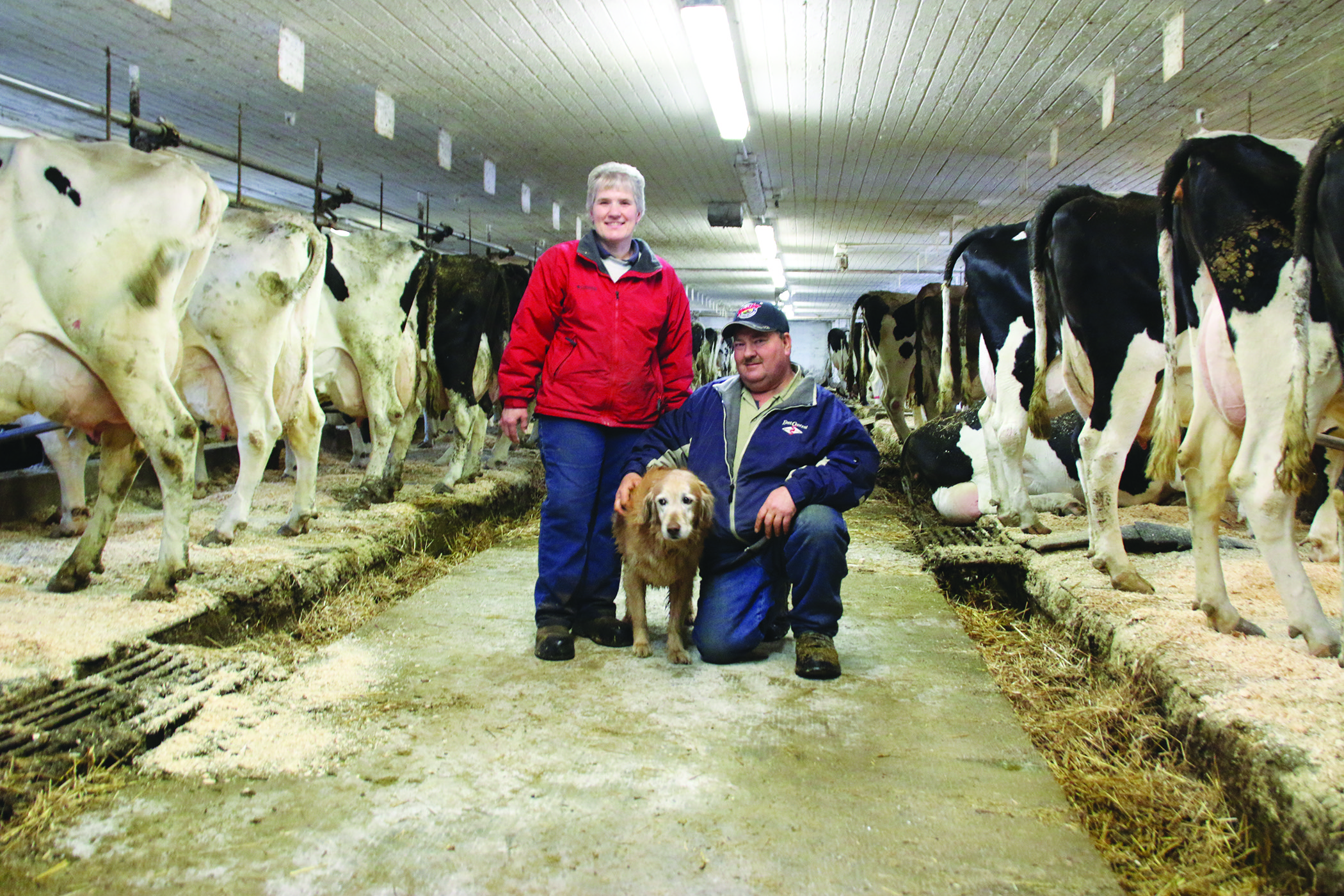
Living the cream: Linda and Steve Meyer are owner-members of the Westby Cooperative Creamery in Westby, Wisconsin, a holdover from an era when co-ops helped independent farmers make a good living.
by Leah Douglas
Corporate-run agricultural co-ops are squeezing the very farmers they’re supposed to protect. Making them work again could help revive the heartland.
Should you ever find yourself crossing the Coon Prairie, you’ll come in good time to a place where the speed limit slows and a wooden sign reads “Velkommen til Westby.” Affixed below are insignias from the Jaycees, the Kiwanis Club, and other local fraternity groups, and a plaque reading “ ’78 ’85 ’86 State Football Champs.” Founded by Norwegian settlers in the nineteenth century, today Westby, Wisconsin, is a hamlet of 2,200, populated mostly by their descendants.
Unlike most farm towns across middle America, Westby is holding its own. South Main Street is graced by the Treasures on Main antique shop, Dregne’s Scandinavian Gifts, and Borgen’s Café, where a hanging sign promises “Good Food” to passersby. There’s also the handsome but unpretentious Bekkum Memorial Library, dedicated in 1986 with more than 16,000 books. Few, if any, rich people live here, but poor people are rare, too. Thanks in part to Westby’s strong support for its public schools, 90 percent of the adult population has graduated from high school and more than one in five has a bachelor’s degree or higher, roughly in line with national averages.
If you stay a spell in Westby, you’re likely to notice another of its distinguishing features. Most of the major businesses in town are cooperatives, meaning they’re owned by the same people who use their services. The local phone, cable, and Internet service provider is a co-op dating back to 1950, when local farmers, tired of waiting for distant monopolies to run wires to their homesteads, got together and formed their own telephone company. Similarly, the local electrical utility is a co-op formed in 1938 to bring electricity to the countryside when the power companies didn’t see enough profit in it. The Vernon Electric Cooperative, part of the region’s larger Dairyland Power Cooperative system, is still going strong as it expands into solar and continues to write checks to its 10,000 local owner-users for their share of its surplus revenues. Meanwhile, the Westby Co-op Credit Union offers Westby residents the chance to be their own bankers, and an old-line farmers’ co-op, now called Accelerated Genetics, offers cattle-breeding services to its members.
And then there’s Westby’s most storied cooperative business, the Westby Cooperative Creamery. It dates back to 1903, when dairy farmers in the surrounding area each pitched in $10 to form a co-op that would provide a stable and competitive market for their milk. Today, around 220 local dairy farm families share ownership of the co-op, many of them third-, fourth-, or even fifth-generation “patrons,” as they’re known locally.
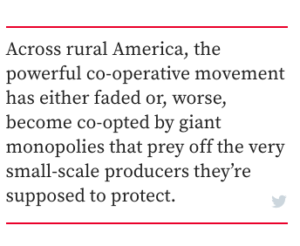 Every day, a dozen gleaming silver tank trucks transport both conventional and organic milk from these local family farms to a brick creamery roughly the size of a small supermarket on Main Street. The creamery employs about 130 people and generates $50 million in revenue for the local economy, turning out products ranging from cottage cheese and yogurt to sour cream and French onion dip. You can buy Westby-brand milk products at the small store on the premises or at selected outlets throughout the region, from the Piggly Wiggly in Beaver Dam, Wisconsin, to the Hy-Vee in Owatonna, Minnesota. They’re also now available online.
Every day, a dozen gleaming silver tank trucks transport both conventional and organic milk from these local family farms to a brick creamery roughly the size of a small supermarket on Main Street. The creamery employs about 130 people and generates $50 million in revenue for the local economy, turning out products ranging from cottage cheese and yogurt to sour cream and French onion dip. You can buy Westby-brand milk products at the small store on the premises or at selected outlets throughout the region, from the Piggly Wiggly in Beaver Dam, Wisconsin, to the Hy-Vee in Owatonna, Minnesota. They’re also now available online.
Darin Von Ruden, an organic dairy farmer and the president of the Wisconsin Farmers Union, says he joined the co-op in 1991 because “it’s still a true cooperative.” He’s pleased that it’s not controlled by highly paid executives who live somewhere else, but by active local farmers like him who “[milk] cows morning and night.” As a part owner of the co-op, he is not only paid for his raw milk, but also shares in the revenue the creamery earns from selling milk and milk products to food processors, retailers, and the public.
All in all, Westby is a corner of rural America that’s still modestly prosperous. And while its legacy of locally controlled cooperative businesses isn’t the only reason, it’s a big part of the story. Local farmers are not totally at the mercy of giant agribusinesses when they bring their products to market. Their ownership of the Westby creamery allows them to cut out middlemen and bargain collectively with food processors and retailers to get a fair price. The rest of the town benefits as well from the creamery and the other locally owned co-ops, as money and power that would otherwise flow to the absentee owners and managers of distant corporations instead stay within the community.
But Westby is the exception, not the rule. It’s a holdout from an earlier era when co-ops helped farmers and rural communities keep a much larger share of the nation’s wealth than they do today. Most everywhere else across rural America, the powerful cooperative movement has either faded or, worse, become co-opted by giant monopolies that prey off the very small-scale producers they’re supposed to protect. In that way, they reflect a broader change in the economy. While pretending to represent farmers’ interests, these co-ops in fact dictate prices to farmers just as Amazon dictates prices to book publishers and Walmart to its suppliers.
The depressed state of rural America is getting a fresh look as a result of the 2016 election, and rightly so. People are asking how to bring back rural prosperity and restore small-town civic life. A good first step would be to recreate the successes of places like Westby. That starts by asking why co-ops aren’t doing the same thing elsewhere.
For Vince Neville, it was trucking. The independent New York State dairyman, who passed away last year, complained that Dairy Farmers of America used its control over local milk haulers to prevent him from doing business with anyone else. For Garrett Sitts, it was the abuse of food safety protocols. He charges that milk inspectors controlled by DFA threatened him and many other farmers with health care violations if they dared to raise questions about DFA’s business practices. For Jonathan Haar, it was a failed attempt to escape DFA’s grip. After nearly ten years with DFA, he tried to leave for another co-op, Agri-Mark. But after promising negotiations, Agri-Mark suddenly went silent. Haar says he was told that Agri-Mark and DFA had an unwritten agreement not to work with each other’s farmers.
Over the last several years, dairy farmers like Haar, Neville, and Sitts have banded together with thousands of others to sue DFA, the largest milk processor in the country and possibly the world. They charge that DFA conspires with other large agribusinesses to drive down the prices they receive for their milk. And they say DFA retaliates against any farmers who complain or try to escape its clutches.
In a statement, DFA senior vice president Monica Massey said, “These allegations are ridiculous. Indeed, a small sliver of farms have brought litigation. There are no facts to back up the claims.”
The odd thing is that the farmers who are suing DFA also own it. At least on paper, DFA is a co-op. Just like the Westby Cooperative Creamery, it’s supposed to work on behalf of its member farmers. But DFA certainly doesn’t look or behave like Westby.
In 2006, DFA got rid of its private jet after it became too controversial, but today its executives are still doing quite well for themselves. In 2017, they moved into a spanking-new $30 million world headquarters in Kansas City that they had built to their own specifications. The sprawling, glass-enclosed, 110,000-square-foot building, designed by the global architect firm HOK, has amenities like bocce and basketball courts, a gym, family rooms, and a milk bar “where employees can help themselves to a variety of milk flavors all day long,” in the words of the building’s designer.
Artistic features pay homage to DFA’s origins and continuing formal status as a dairy co-op. As you enter the lobby, you’re greeted by a glossy, white, 25-foot-high, floor-to-ceiling molded sculpture meant to evoke a cascading, seamless flow of milk. Other flourishes include faux barn boards and walls decorated with molded white patterns depicting old-fashioned milk bottle caps, cow tags, cheese graters, and ice cream scoops. Acquiring and installing these objets d’art cost $1.5 million.
When the facility opened in June, president and CEO Rick Smith praised its appropriation of old-time dairy imagery, telling a trade publication, “This building is a testament to our family farmers and the sustainable practices they employ on their dairies each and every day.” Other executives spoke of how the new headquarters made DFA such a cushy place to work. Monica Massey, senior vice president and chief of staff, told the same publication, “Our goal is to be an employer of choice in Kansas City and this building and all its amenities reflects that commitment to focus on employee satisfaction.”
Yet if DFA’s management is pleased with its new digs, many of its putative owners are not. The distance DFA has traveled from a traditional dairy co-op is breathtaking. The co-op reported a net income of nearly $132 million in 2016; meanwhile, the number of dairy farmers in the U.S. continued to plummet, hitting a new low of 58,000. Historically, the role of a dairy co-op was to engage in collective bargaining with the typically much larger corporations that process and market milk and milk products. This was, and remains, crucial to farmers’ receiving a fair price, because of what economists call monopsony power.
Monopsony occurs in markets where many sellers compete for the business of a few big buyers. In such markets, sellers have to accept the terms and prices the buyers dictate. This has always been a particular problem for individual dairy farmers because there are always more of them than there are food processors and potential buyers of their raw milk. Making matters worse, milk is a highly perishable product. Unlike with grain, farmers can’t store it in silos waiting for the right price.
In days of old, the co-op was the answer to the dairyman’s monopsony problem. Co-ops typically negotiated on behalf of their member farmers with food processors like Borden or Carnation Evaporated Milk and with retailers that sold dairy products under their own private labels. Co-ops also helped farmers negotiate better rates from the trucking firms they depend on to get their milk to market on time. In some cases, such as in Westby, dairy co-ops also became involved in processing and marketing their own milk products. Perhaps the best-known example of this is Land O’Lakes, which started out as the Minnesota Cooperative Creamery Association in 1921.
This system never worked perfectly. During periods of overproduction and slack demand, dairy farmers’ income has depended on federal government “marketing orders” that maintain the minimum prices they can be paid for raw milk. But throughout most of the twentieth century, co-ops helped to maintain reasonable competition within the dairy industry by making sure that large agribusinesses didn’t abuse their monopsony power in negotiations with farmers.
Today, however, DFA has upset that balance by joining forces with the parties on the other side of the negotiating table. The organization says it represents more than 13,000 member farmers in forty-eight states. But it simultaneously has grown to the point that it owns or controls entities up and down the entire dairy industry supply chain, from milk truckers to food processors to marketers. It’s an obvious conflict of interest: the less these entities have to pay DFA farmers for their milk, the more money they—and DFA—make. According to its 2016 financial statement, 60 percent of DFA’s net income that year came from “non-member business earnings,” none of which was shared with members.
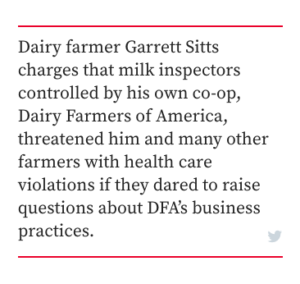 DFA claims that controlling the supply chain helps protect farmers. “Cooperatives of any reasonable size, in the U.S. and around the world, own manufacturing and trucking assets,” Massey said.
DFA claims that controlling the supply chain helps protect farmers. “Cooperatives of any reasonable size, in the U.S. and around the world, own manufacturing and trucking assets,” Massey said.
In all, DFA controls about 30 percent of all milk sales nationally and a far higher share in many regions. That means that many, if not most, dairy farmers don’t have a way to even get their milk off their farms without accepting the terms imposed by DFA. “You can’t look at DFA as anything now but a corporation,” says Nate Wilson, a longtime journalist for the Milkweed, a publication that covers the dairy industry. “The management of DFA is consistently working against the rank-and-file members.”
To all appearances, Gary Hanman was a man of the people. Often seen in worn overalls, muddy boots, or bright red suspenders, the Missouri native had a down-home appeal that charmed the many dairy farmers he worked with. His affability helped him climb the ladder in the dairy cooperatives where he made his name. As the head of Mid-America Dairymen, he grew the cooperative through nearly fifty mergers. Then, in 1998, he spearheaded the biggest merger in dairy cooperative history, uniting Mid-America and three others to form Dairy Farmers of America.
From there, Hanman went on to expand DFA’s vertical control over milk production and distribution. For example, he and DFA worked to engineer mergers giving the food processor Dean Foods a dominant market share of milk sales in many regional markets—and then forged deals with Dean making DFA its sole supplier. Meanwhile, through its marketing arm, Dairy Marketing Services, DFA’s dominion extended to milk testing and hauling from farm to market in many parts of the country.
All this was done, Hanman said, in order to help the little guy, the local dairy farmer, to better bargain with giant food processors and retailers, who were themselves merging at a frenzied pace. The story Hanman told dairy farmers was that they had to let him consolidate their local co-ops into a vertically integrated Goliath in order to stand up to the even bigger agribusiness giants.
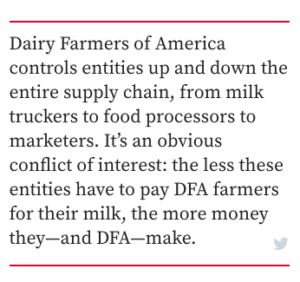 But, over time, more and more farmers began to wonder who Hanman was actually working for. During his time at DFA, executives traveled on a private jet, called Delta Foxtrot Alpha. Hanman made $31 million during his seven years as CEO of the cooperative, while, as the New York Times has reported, other executives and DFA business partners also came away with multimillion-dollar side deals.
But, over time, more and more farmers began to wonder who Hanman was actually working for. During his time at DFA, executives traveled on a private jet, called Delta Foxtrot Alpha. Hanman made $31 million during his seven years as CEO of the cooperative, while, as the New York Times has reported, other executives and DFA business partners also came away with multimillion-dollar side deals.
Hanman’s indulgences didn’t sit well with dairy farmers. Farmers’ margins narrowed each year he was at the helm of DFA, and many lost their farms. During the Clinton and George W. Bush administrations, some tried to interest the U.S. Department of Justice in prosecuting DFA for antitrust violations. But regulators made only a minimal effort to investigate anticompetitive practices in the dairy sector. In 2004, the Department of Justice began an investigation into the relationship between Dean and DFA, but it ground to a halt in 2006 for unexplained reasons. Peter Carstensen, a law professor at the University of Wisconsin at Madison and an expert on the dairy industry, says that the DOJ “is absolutely petrified of the dairy industry,” and “that’s the only explanation for their failure to enforce the antitrust law.”
In 2008, the Commodity Futures Trading Commission fined Hanman, who had retired in 2006, and another DFA executive $12 million for illegally manipulating the price of milk by purchasing block cheddar cheese on the Chicago Mercantile Exchange. Hanman’s successor, CEO Rick Smith, sold off the corporate jet and promised other reforms. But none of these efforts brought structural change to the role and power of DFA.
One reason DFA has gotten away with all this is, perversely, its legal status as a co-op.
Coming into the 1920s, the cooperative movement in the United States was flourishing, particularly in the agricultural sector. Not only was the cooperative that became Land O’Lakes taking off, so were co-ops like the American Cranberry Exchange, which handled 66 percent of the nation’s cranberries, and the California Associated Raisin Company, which shipped 86 percent of U.S. raisins. The promise of collective ownership became an appealing platform for political leaders in both parties, as it provided an all-American alternative to both monopoly capitalism and socialism. It was also especially popular among civil rights leaders. The scholar Jessica Gordon Nembhard wrote in her 2014 book Collective Courage that “almost all African American leaders were involved in Black co-ops in some manner.”
But as cooperatives grew in size and power, they also attracted powerful enemies. Large food processors charged that farmer co-ops were illegal cartels, and pressed regulators to prosecute them under the Sherman and Clayton Antitrust Acts. After decades of debate and unsettled law, two Republican members of Congress offered what they hoped would be a solution. They were Arthur Capper, who served as governor of Kansas from 1915 to 1919 and then as a senator from 1919 to 1949, and Andrew Volstead, a congressman from Minnesota who had recently become chair of the House Judiciary Committee.
The two men persuaded Congress and the Harding administration that as long as co-ops were comprised of genuine, small-scale producers, they should be largely exempt from antitrust prosecution. “Participation by farmers in the marketing of farm products through cooperative associations,” Capper argued, amounted to “giving them the right to bargain collectively with buyers.” This would result, he promised, “in stabilizing the market, preventing waste, and . . . [giving] the producer and the consumer their due.”
The Capper-Volstead Act of 1922 establishes an antitrust exemption for farmer co-ops, which has left room for intensive lobbying and litigation over just who is and is not a real farmer. In 1977, the Fifth Circuit Court of Appeals ruled that members of farmer co-ops had to be “ordinary, popular sense of the word ‘farmers,’ ” and not processors, packagers, or other supply chain actors. The court also asserted that at the time of its passage, Capper-Volstead was meant to protect the interests of “small, individually-owned farms.”
But in subsequent years, neither the courts nor Congress nor successive Democratic and Republican administrations have applied any real scrutiny to the question of whether entities operating as co-ops are really representing the little guy. The Capper-Volstead Act empowers the secretary of agriculture to take action against a co-op that engages in anticompetitive behaviors, but that power has never been used. Because of that, Dairy Farmers of America has been able to expand into all aspects of food processing, marketing, and distribution while still being protected as a co-op from antitrust prosecution.
Frustrated by the refusal or inability of government officials to constrain DFA’s power, thousands of DFA farmers have banded together to bring their own private class-action antitrust lawsuits, charging DFA with engaging in conspiracies to fix prices. The results have been mixed. One of these suits, brought by DFA members in the Southeast, ended when DFA agreed in 2013 to a settlement of $140 million. Another, brought by 8,900 members in the Northeast, led to a $50 million settlement, or about $4,000 per farmer. But it is being contested by some of the plaintiffs, who charged that DFA colluded with their attorney and strong-armed other farmers into signing the settlement. In the most recent development, a group of 115 DFA members won standing to pursue a separate suit against DFA. In refusing DFA’s motion to dismiss the case, the judge ruled that because the plaintiffs are clearly subject to DFA’s monopsony power, they “may plausibly allege anti-trust injury.” Just maybe they’ll get justice before they go broke.
What lessons can we take from this sad story? One, obviously, is that it’s high time for Congress to take a hard look at the laws governing co-ops. It needs to be made clear that no corporation gets the legal privileges of a co-op unless it truly represents the little guy without any conflicts of interests. While there is nothing wrong per se with co-ops becoming vertically integrated, the law should ensure that the money co-ops make on all their operations goes back directly to their members.
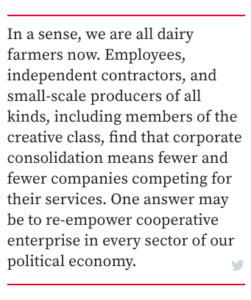 Another lesson is that monopoly begets monopoly. Gary Hanman wasn’t wrong when he told farmers that the increasing concentration of ownership among agribusinesses meant that farmer co-ops had to grow bigger, too. But he didn’t tell them that as their traditional co-ops merged and consolidated into the Goliath that became DFA, they were creating a new oppressor. This dynamic is what Supreme Court Justice Louis Brandeis meant when he referred to “the curse of bigness.”
Another lesson is that monopoly begets monopoly. Gary Hanman wasn’t wrong when he told farmers that the increasing concentration of ownership among agribusinesses meant that farmer co-ops had to grow bigger, too. But he didn’t tell them that as their traditional co-ops merged and consolidated into the Goliath that became DFA, they were creating a new oppressor. This dynamic is what Supreme Court Justice Louis Brandeis meant when he referred to “the curse of bigness.”
The final lesson is that we are all dairy farmers now. As more and more sectors of the economy become highly concentrated, more and more of us become victims of monopsony power. That’s true if you’re a nurse trying get a raise after the last two hospitals in town merge. It’s true if you’re a doctor trying to negotiate fees with the last remaining health insurer doing business in your county. It’s true if you’re a small manufacturer trying to get Walmart to stock your product. It’s true if you’re a small retailer who can’t reach customers except by agreeing to the fees and terms that Amazon sets. And it’s true if you work for a newspaper, magazine, or journal that has no choice but to take the prices Google or Facebook offer for internet ads.
Everywhere we turn, employees, independent contractors, and small-scale producers of all kinds, including members of the creative class, find that corporate consolidation leads to fewer and fewer companies competing for their services. Stronger antitrust enforcement is part of the answer. But so is finding new ways of re-empowering cooperative enterprise in every sector of our political economy.